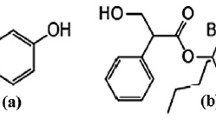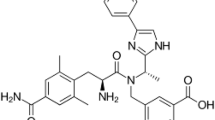Abstract
Objective
The foremost purpose of the planned research was to develop and validate a cost-effective, sensitive, precise and trouble-free RP-HPLC procedure with superior response for the simultaneous analysis of Azelnidipine and Telmisartan in pure blended powder and their fixed-dose combination tablet form.
Method
WATERS reverse phase HPLC instrument with PDA detector was selected to separate Telmisartan and Azelnidipine with fine resolution. Agilent C18 column (150 × 4.6 mm, 5) and a mobile phase composition of 0.1% V/V ortho phosphoric acid in water and acetonitrile (40:60 v/v) were used. Mobile phase was pumped to column with 1 ml/min flow rate and the eluted compounds were detected at 260 nm. The proposed method validated as per ICH specifications. Forced degradation studies were performed with the developed method to ensure the stability of analytes by the proposed method.
Result
The retention times of Azelnidipine and Telmisartan were observed at 2.2 and 2.9 min respectively. Linearity concentrations were observed for Azelnidipine and Telmisartan in the set of 2–12 µg/mL and 20–120 µg/mL respectively. The %RSD of both intraday and inter-day precision was determined in the range of 0.7–1.4. The average percentage recovery of both analytes was in the range of 99.64–100.92%. The results confirmed that the proposed method was cost-effective, precise and trouble-free with superior sensitivity. Study of the percentage degradation both analytes in the presence of various stressed conditions revealed the stability of the current method. Both the drugs were highly acidic sensitive compared with remaining stress conditions such as base hydrolysis, oxidation.
Conclusion
The proposed liquid chromatographic method was highly effective in separation of Azelnidipine and Telmisartan with good sensitivity, lower retention time and economical solvent system. Hence, the proposed method can be considered in pharmaceutical industry.
Graphical Abstract








Similar content being viewed by others
Availability of Data and Material
All data and material should be available upon request.
Abbreviations
- AZD:
-
Azelnidipine
- TLM:
-
Telmisartan
- FD:
-
Forced Degradation
- ICH:
-
International Committee for Harmonization of Technical Requirements for Registration of Pharmaceuticals for Human Use
- RP-HPLC:
-
Reverse Phase High Performance Liquid Chromatography
- LOD:
-
Limit of Detection
- LOQ:
-
Limit of Quantification
- RSD:
-
Relative Standard Deviation
- SD:
-
Standard Deviation
References
Deppe S, Böger RH, Benndorf WJ, R (2010) Telmisartan: A review of its pharmacodynamic and pharmacokinetic properties. Expert Opin Drug Met 6(7):863–871
Sharpe M, Jarvis B, Goa KL (2001) Telmisartan: A review of its use in hypertension. Drugs 61(10):1501–1529
Gosse P (2006) A review of telmisartan in the treatment of hypertension: Blood pressure control in the early morning hours. Vasc Health Risk Manag 2(3):195–201
Wellington K, Scott LJ (2003) Azelnidipine Drugs 63(23):2613–2621
M Watanabe, T Hirano, S Okamoto, S Shiraishi, S Tomiguchi, M Uchino 2010 Azelnidipine, a long-acting calcium channel blocker, could control hypertension without decreasing cerebral blood flow in post-ischemic stroke patients. A 123 I-IMP SPECT follow-up study. Hypertens Res 33(1):43–48
U Shewale Vishal, SS Aher, RB Saudagar 2019 Azelnidipine: A review on therapeutic role in hypertinsion. J Drug Deliv Ther 9(3-s):1002–1005
Chen BL, Zhang YZ, Luo JQ, Zhang W (2015) Clinical use of azelnidipine in the treatment of hypertension in Chinese patients. Ther Clin Risk Manag 11:309–318
Raskapur KD, Patel MM, Captain AD (2012) UV-Spectrophotometric method development and validation for determination of azelnidipine in pharmaceutical dosage form. Int J Pharm Pharm Sci 4(1):238–240
Patra BR, Mohan S, Gowda N (2016) Stability-indicating RP-UHPLC method for determination of telmisartan in drug substance and marketed formulation. Int J Pharm Sci Res 7(5):2031–2039
RV Rele, SP Patil 2010 Ultra-violet spectrophotometric method for estimation of azelnidipine from bulk drug and pharmaceutical formulation. Asian J Chem 3(4):1077–1079
Shaina S, Varinder S, Sandeep R, Nitish B (2016) Development and validation of method for the estimation of telmisartan as active pharmaceutical ingredient in tablet dosage form and prepared spherical agglomerates by RP-HPLC. J Pharm Technol Res Manag 4(1):63–79
Prabhakar D, Sreekanth J, Jayaveera KN (2017) Method development and validation of azelnidipine by RP-HPLC. Int J ChemTech Res 10(10):418–423
Bhadoriya U, Dhaked H, Danodia AK (2013) RP-HPLC Method development and validation for estimation of telmisartan in bulk and tablet dosage form. Int J Drug Regul Aff 1(2):61–64
Madukar A, Kannappan N, CB Mahendra Kumar 2015 Analytical method development and validation for the determination of hydrochlorothiazide, amlodipine besylate and telmisartan hydrochloride in multicomponent tablet dosage form and in biorelevant media by RP-HPLC techniques. Int J Pharm Sci. 7(1) 218–25
Chaudhary BR (2017) Development and validation of stability indicating gradient RP-HPLC method for simultaneous estimation of telmisartan and chlorthalidone in bulk API and fixed dose combination. World J Pharm Res 6(10):1015–1029
Chabukswar AR, Jagdale SC, Kumbhar SV, Desai DJ, Kuchekar BS, Lokhande PD 2010 HPLC method development for telmisartan and amlodipine. Res J Pharm Technol 3(4):1227–30.
Nalwade S, Ranga Reddy V, Durga Rao D, Koteswara Rao I (2011) Rapid simultaneous determination of telmisartan, amlodipine besylate and hydrochlorothiazide in a combined poly pill dosage form by stability-indicating ultra performance liquid chromatography. Sci Pharm 79(1):69–84
Wankhede SB, Tajne MR, Gupta KR, Wadodkar SG (2007) RP-HPLC method for simultaneous estimation of telmisartan and hydrochlorothiazide in tablet dosage form. Indian J Pharm Sci 69(2):298
Doshi N, Sheth A, Sharma A, Dave JB, Patel CN (2010) Validated RP-HPLC method for simultaneous estimation of Rosuvastatin Calcium and Telmisartan in pharmaceutical dosage form. J Chem Pharm Res 2(2):252–263
Patel JK, Patel NK (2014) Validated Stability-Indicating RP-HPLC Method for the simultaneous determination of azelnidipine and olmesartan in their combined dosage form. Sci Pharm 82(3):541–554
M Kumar, U Chandra, P Gupta, P Manchanda 2021 A stability indicating RP-HPLC method validation for simultaneous estimation of azelnidipine and telmisartan in a fixed-dose combination. Int J Pharm Sci Drug Res 13(3)
K Konam, SR Kanala SR 2021 Method development and validation for the simultaneous estimation of azelnidipine and telmisartan in pharmaceutical formulation by high performance liquid chromatography. Bull Env Pharmacol Life Sci 10(2): 19–27
Acknowledgements
The authors are thankful to Department of Pharmaceutical Analysis, GITAM University, Vishakhapatnam, and Dr. A. Srinivas Rao, Principal, Bhaskar Pharmacy College, moinabad for his continuous support.
Funding
It is self financed, no funding was sponsored from any organization, funding agency and non -profit research bodies.
Author information
Authors and Affiliations
Corresponding author
Ethics declarations
Conflict of Interest
The authors declare that there is no conflict of interest.
Ethics Approval and Consent to Participateclusion
No animals and human subjected used in this study.
Supplementary Information
Below is the link to the electronic supplementary material.
Rights and permissions
Springer Nature or its licensor (e.g. a society or other partner) holds exclusive rights to this article under a publishing agreement with the author(s) or other rightsholder(s); author self-archiving of the accepted manuscript version of this article is solely governed by the terms of such publishing agreement and applicable law.
About this article
Cite this article
Godela, R., Gummadi, S., Pathak, S. et al. RP-HPLC–PDA Approach for Concurrent Analysis of Telmisartan and Azelnidipine in Bulk and Commercial Tablets. Chemistry Africa 6, 393–403 (2023). https://doi.org/10.1007/s42250-022-00483-5
Received:
Accepted:
Published:
Issue Date:
DOI: https://doi.org/10.1007/s42250-022-00483-5




